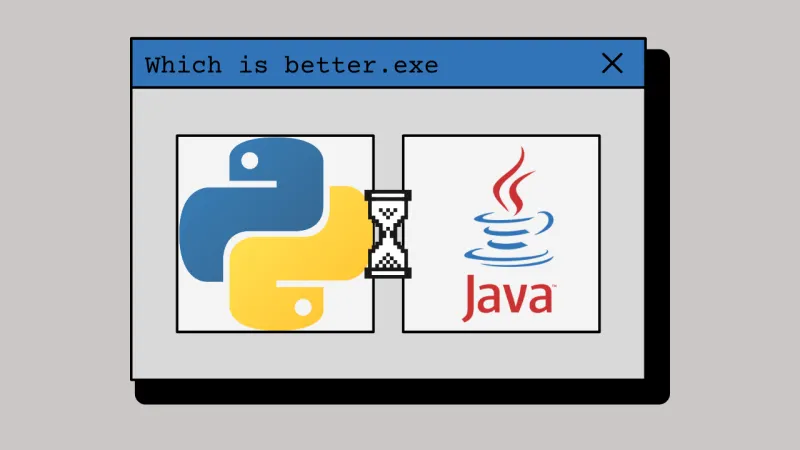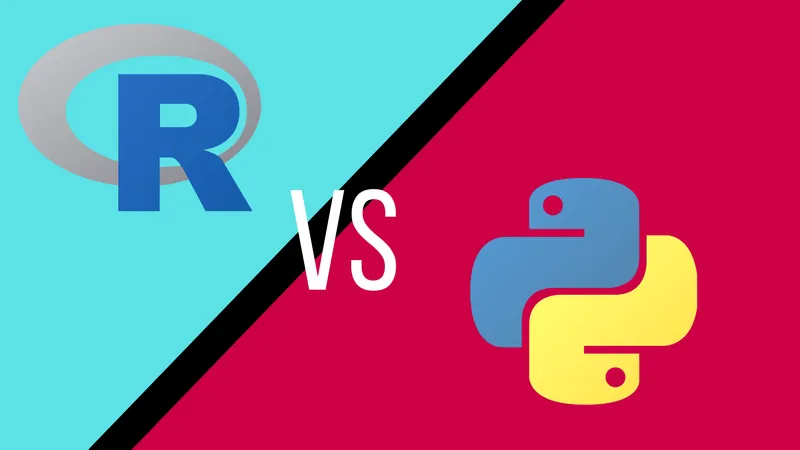Rust and Python contrast in a unique way because while they both provide back-end web support, Python thrives as a flexible and consistent language, while Rust makes a name for itself with raw power and speed.
Python, named after the comedic group Monty Python, is a high-level, interpreted, general-purpose language created by Guido van Rossum at Centrum Wiskunde & Informatica (CWI) in 1991. Python is dynamically typed and supports procedural, functional, and object-oriented programming.
Python’s most famed for its intuitive design and work with AI, web development, and Big Data.
Alternatively, if you can imagine C recreated for a modern world, then you get Rust.
Rust is a high-level, multiparadigm, general-purpose language created by Graydon Hoare at Mozilla Research, with help from Dave Herman and Brendan Eich. It first appeared in 2010, but the first stable release wasn’t until 2015, and it was designed for maintaining safety and stability without sacrificing performance.
Because of Rust’s ability to handle CPU-heavy operations, it’s commonly used for developing enterprise systems, virtual reality, browser components, file systems – any project where performance is a top priority.
Now that we have a better idea of what we’re dealing with, it’s time to find out which language is best! I’ll start by breaking down which language is best for beginners, then compare performance, salary, and see which works best for machine learning, data science, and system development.
Rust vs Python: Which Is Best for Beginners? 🔗
When choosing your first programming language, you want it to be easy to learn, but you also want it to be versatile, so you have a wide range of programming career options.
Python is an excellent beginner language because of its insanely low learning curve. This is due to Python’s advanced readability (it literally looks like you’re writing in plain English) and simplistic style of coding.
Python also supports functional and procedural programming, the two easiest paradigms to learn, and comes with an amazing set of standard libraries, giving you access to an extensive list of facilities.
We have an interactive course so you can learn functional programming.
Aside from being easy to learn, Python’s also versatile. Its simplistic but powerful design has made it an excellent language for experimental fields, like machine learning and data science, but its security has also made it a key choice in back-end web development.
Both are innovative fields that offer very different environments.
It’s also incredibly popular, with companies like Spotify, Netflix, and Dropbox using Python to develop their platforms, along with its massive community of developers.

Rust, on the other hand, works better as a later foray into programming. If you know C++ or C, Rust has a similar syntax so it may be easier for you to pick up.
Rust has a moderate-to-hard learning curve, and that’s mostly to do the power it places in the hands of the developer. Python manages memory for you, while Rust requires the programmer to do it themselves. While it’s more convenient to work in Python and let the language deal with memory, Rust’s performance comes with the cost of some manual work.
Rust also has an interesting multi-paradigm approach to programming. As quoted in the Programming Rust book, it’s:
“not really an object-oriented language, although it has some object-oriented characteristics. Rust is not a functional language […] It’s probably best to reserve judgment about what sort of language Rust is, and see what you think once you’ve become comfortable with the language.”
Rust technically supports OOP and functional programming, but it doesn’t satisfy all the modern principles of either paradigm, so you’re left floating in limbo until you discover how it works for you.
This is an intriguing aspect for experienced programmers that are familiar with the different paradigms and want a language to mesh to them, but for a beginner, stricter rules are better for creating your foundation for programming.
Overall: Rust lacks that easy intuitive design that makes Python such a clear shout for beginners.
Rust vs Python Salary: Which is higher paid? 🔗
Like most developer roles, both Rust and Python programming jobs pay well.
According to the Stack Overflow Developer 2020 survey, Rust developers on average earn around $130k a year in the US, and Python developers earn around $120k. So, they’re very similar, with Rust earning a bit more.
In the same survey, Python was reported as the most wanted by developers, meaning it was the number one language developers wanted to learn, and Rust was voted most loved, but both languages sit at the top in their respective categories.
Essentially, developers love Rust and Python, and in both salary and popularity, there’s no wrong choice.
Rust vs Python Performance 🔗
Their syntaxes aren’t the only similarity between Rust and C++. One of the main selling points of Rust is its incredible performance, which is a trait C++ shares. However, Rust has a unique way of reading like a high-level language but performing like a low-level one. This is thanks to its compile-time memory management and modern toolchain.
Even though Rust is a high-level language, it still possesses fewer abstractions, so it compiles faster. This also means you have more low-level control over what you’re programming, further improving performance.
Oppositely, Python’s intuitiveness comes from having more abstractions. So, it takes longer to interpret, and interpreted code is already much slower than compiled machine code.
Rust’s memory management system is also seriously efficient as the code is checked for invalid memory reference leaks, as well as other irregular behavior, at compile time. Python, however, uses a garbage collector to manage memory, which adds notorious drag time to performance.
It’s not all bad for Python though. Some extensions help increase performance, like PyPy and Cython, but they’re better for specific applications.
In the end, Rust’s origin is founded on speed and stability, and it shows.
Rust vs Python for Machine Learning 🔗
Machine learning and Artificial Intelligence are arguably the “last frontier” of computer science, and needless to say, it’s a fascinating time to get involved.
Python is currently the leading language in ML, with 57% of data scientists and machine learning developers using it, and 33% prioritizing it for development.
Its widespread adoption in the field can likely be attributed to Python’s simplistic and consistent design. ML is largely experimental, and coding in a language with high readability makes experimenting not only easier but more enjoyable. Academics and researchers need to be able to read code, and Python is nothing if not human-readable.
Python’s legible syntax makes it consistent and a stable language to experiment with as well. As a general-purpose language, Python can create anything, and its platform independence lets you implement it anywhere. It’s also ideal for fast prototype creation.
Aside from Python’s structural benefits, it has phenomenal library and framework support like Keras, TensorFlow, scikit-learn, and loads more.
There’s also the simple fact that the community chose Python. As we saw above, it’s the most used language by ML developers, and with that comes a large community and investment from companies to develop more ML-based features for the language.
Rust by all means has the capabilities of supporting machine learning. It’s stable, powerful, and fast, however, the interest isn’t there.
Rust lacks the libraries and frameworks needed to manage ML, and tech giants and developers aren’t developing them - they’re already entrenched in languages like Python and Java that have the necessary tools.
The community truly does make or break a language’s potential in any field, because it directly influences the demand and creation of tools to support them. Overall, Python has the intrinsic and communal support to dominate as a machine learning language.
Hot tip: Machine learning is essentially algorithms. Algorithms that leverage statistics to learn patterns and behaviors, so the more advanced you are with algorithms the better your ML skills become.
Rust vs Python for Data Science 🔗
Much like machine learning, Python also reigns supreme in data science, and for similar reasons.
When handling Big Data, having a straightforward syntax minimizes complexity. As I stated earlier, Rust keeps you hovering in limbo until you find your version of the language, and experimenting with the code while in an experimental field creates a very chaotic environment.
And sure, by this point, you may have already nailed down how you and your team write your style of Rust, but not every developer on the team will use it in exactly the same way, and Python’s clear syntax can offer team-wide consistency.
Python also has fantastic data management libraries and frameworks like Seaborn for top-notch data visualization, Pandas for data analysis, NumPy for large-scale mathematical tasks, and Statsmodel for statistical model building – just to name a few.
Partnered with the industry’s support, Python’s an unbeatable asset.
Rust has potential, but it struggles with visual implementations and has few data science libraries. So, you’ll need to be incredibly confident with Rust as you’ll have to build most things from scratch.
The community also isn’t as big, but it’s very excited about the possibilities Rust poses for the industry. So, it’s not a complete no, but if you’re keen to work as a data scientist now, then Python is your best bet. But definitely keep a lookout for Rust in the future.
Hot tip: Once you’re comfortable with Python, take a Big O data structure class to improve how you interact with the data.
Rust vs Python for System Development 🔗
Now it’s time to give Rust its due credit.
Power and speed is the top priority in system development. Lower-level systems like remote controls, IOT devices, operating systems, and kernels rely heavily on CPU operations and the ability to execute multiple algorithms at a time, all while maintaining performance, and Rust does this seamlessly.
Rust picks up where C/C++ falls short when it comes to memory management. Rust performs verification for thread safety and memory safety at compile-time, so you don’t have to rely on typical run-time checks. Plus, Rust doesn’t allow for null exceptions preventing you from making mistakes in the first place.
Rust also maintains the ability to manage low-level details and multi-threading, giving you intricate control over the system. Not only that, but you can disconnect from the low-level standard library integrations and incorporate your own.
Rust isn’t just for development but also for system maintenance. You can maintain systems by cross-compiling new code with existing code, and it has a package manager that interacts with the rest of the ecosystem.
Python, however, simply doesn’t have the raw power for this kind of work.
Python has excellent memory management, but it relies on a garbage collector, which hinders performance. It’s not as noticeable with smaller applications, but larger projects suffer dearly.
Python also doesn’t offer the same kind of low-level control. What makes Pythons so easy to read is the amount of “batteries included”, hiding all of those low-level details.
In the end, Rust brings a lot of modern features to the field that weren’t previously there, namely in memory and low-level management. Don’t take it from me though, take it from Amazon who uses it on multiple AWS services like Amazon Firecracker, Amazon EC2, and Amazon CloudFront.
Rust vs Python: The Final Verdict 🔗
To be frank, there is no “which is better Python or Rust” because the two languages are almost incomparable.
Rust is modern and robust. Its performance rivals that of C/C++ and it’s a beast at developing and managing large enterprise systems, embedded systems, and file systems without breaking a sweat.
However, it’s slow to be adopted by most companies because so few developers know it, but that doesn’t diminish this language’s immense potential.
Python, on the other hand, is flexible and intuitive. Its consistent but malleable structure makes it the perfect companion for highly experimental fields like data science and machine learning, but also for startup culture like back-end web development. And it has a massive community to match.
So, it’s really about which one is best for you and your goals. Regardless, both languages receive endless positivity from the computer science community and promise a fulfilling (and well paid) career to anyone!
For Further Study
If you’re looking to learn Python, we built our Learn Python course to take anyone from a beginner to having all the Python skills to pursue your dream Python programming job, such as in data science.




